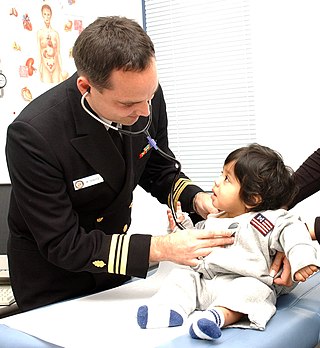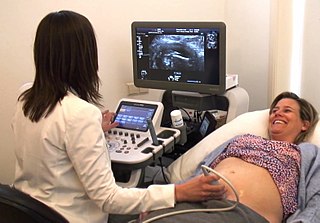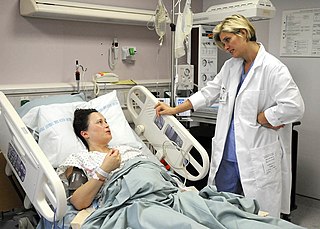
Midwifery is the health science and health profession that deals with pregnancy, childbirth, and the postpartum period, in addition to the sexual and reproductive health of women throughout their lives. In many countries, midwifery is a medical profession. A professional in midwifery is known as a midwife.

A nurse practitioner (NP) is an advanced practice registered nurse and a type of mid-level practitioner. NPs are trained to assess patient needs, order and interpret diagnostic and laboratory tests, diagnose disease, formulate and prescribe medications and treatment plans. NP training covers basic disease prevention, coordination of care, and health promotion. One study found that although reasons for referrals to specialists are similar for both physicians and NPs, the quality of documentation in the referrals may be lower for NPs.
An advanced practice nurse (APN) is a nurse with post-graduate education and training in nursing. Nurses practicing at this level may work in either a specialist or generalist capacity. APNs are prepared with advanced didactic and clinical education, knowledge, skills, and scope of practice in nursing.

The Frontier Nursing Service (FNS) provides healthcare services to rural, underserved populations since 1925, and educates nurse-midwives since 1939.
A birth attendant, also known as skilled birth attendant, is a health professional who provides basic and emergency care to women and their newborns during pregnancy, childbirth and the postpartum period. A birth attendant, who may be a midwife, physician, obstetrician, or nurse, is trained to be present at ("attend") childbirth, whether the delivery takes place in a health care institution or at home, to recognize and respond appropriately to medical complications, and to implement interventions to help prevent them in the first place, including through prenatal care. Different birth attendants are able to provide different levels of care.

Nursing is a profession within the healthcare sector focused on the care of individuals, families, and communities so they may attain, maintain, or recover optimal health and quality of life. Nurses can be differentiated from other healthcare providers by their approach to patient care, training, and scope of practice. Nurses practice in many specialties with differing levels of prescription authority. Nurses comprise the largest component of most healthcare environments; but there is evidence of international shortages of qualified nurses. Nurses collaborate with other healthcare providers such as physicians, nurse practitioners, physical therapists, and psychologists. There is a distinction between nurses and nurse practitioners; in the U.S., the latter are nurses with a graduate degree in advanced practice nursing, and are permitted to prescribe medications unlike the former. They practice independently in a variety of settings in more than half of the United States. Since the postwar period, nurse education has undergone a process of diversification towards advanced and specialized credentials, and many of the traditional regulations and provider roles are changing.

Nurses in Canada practise in a wide variety of settings, with various levels of training and experience. They provide evidence-based care and educate their patients about health and disease.

A monthly nurse is a woman who looks after a mother and her baby during the postpartum or postnatal period. The phrase is now largely obsolete, but the role is still performed under other names and conditions worldwide.
Ruth Watson Lubic, CNM, EdD, FAAN, FACNM, is an American nurse-midwife and applied anthropologist who pioneered the role of nurse-midwives as primary care providers for women, particularly in maternity care. Lubic is considered to be one of the leaders of the nurse-midwifery movement in the United States.
Obstetrical nursing, also called perinatal nursing, is a nursing specialty that works with patients who are attempting to become pregnant, are currently pregnant, or have recently delivered. Obstetrical nurses help provide prenatal care and testing, care of patients experiencing pregnancy complications, care during labor and delivery, and care of patients following delivery. Obstetrical nurses work closely with obstetricians, midwives, and nurse practitioners. They also provide supervision of patient care technicians and surgical technologists.
In the United States, certified nurse midwives (CNMs) are advanced practice registered nurses in nurse midwifery, the nursing care of women during pregnancy and the postpartum period. CNMs are considered as midwives.
Midwives in the United States assist childbearing women during pregnancy, labor and birth, and the postpartum period. Some midwives also provide primary care for women including well-woman exams, health promotion, and disease prevention, family planning options, and care for common gynecological concerns. Before the turn of the 20th century, traditional midwives were informally trained and helped deliver almost all births. Today, midwives are professionals who must undergo formal training. Midwives in the United States formed the Midwifery Education, Regulation, and Association task force to establish a framework for midwifery.

A direct-entry midwife is a midwife who has become credentialed without first becoming a nurse. There are direct-entry midwifery programs that prepare students to become Certified Nurse Midwives (CNMs) or Certified Professional Midwives (CPMs). Certified Professional Midwives are known for being "more natural and less intervention oriented." In other words, these midwives typically work outside of the hospital setting in homes and birth centers and do not employ methods for childbirth that physicians in hospitals commonly use such as caesarean section, forceps and other types of equipment and drugs.

A midwife is a health professional who cares for mothers and newborns around childbirth, a specialization known as midwifery.
Nursing is the largest healthcare profession in the United States, with more than 3.1 million registered nurses. Between 2012 and 2022, employment for nurses is projected to grow by 19 percent, which is more than any other profession. Nurses make up the largest component of staff in hospitals but are also able to provide care in clinic settings, patient's homes, schools, nursing homes, public health agencies, and mental health centers. In addition, nurses can be found in the military, in industry, nursing education, and do health care research. Nurses in these various roles and settings can provide direct patient care and case management, but also develop and establish nursing practice and quality standards within complex healthcare systems. As each degree can provide a different level of care for patients and function in vastly different roles, it is important to differentiate between them. The levels of nursing degrees have different educational requirements, licensure, and credentialing that can vary state to state.
Advanced Practice Registered Nurse (APRN) refers to a nurse with advanced education, typically at least a master's degree, and certification by a national certifying program. The APRN provides specialized and multifaceted care and are able to do 60 to 80 percent of preventative and primary care done by physicians. Minnesota Statutes section 148.171, subd. 3 states that in Minnesota, APRN "means an individual licensed as a registered nurse by the board, and certified by a national nurse certification organization acceptable to the board to practice as a clinical nurse specialist, nurse anesthetist, nurse midwife, or nurse practitionerr".

Ronnie Sue Lichtman, is a midwife, educator, writer and advocate for women's health. She has published widely for both lay and professional audiences. The Chair of the Midwifery Education Program at The State University of New York (SUNY) Downstate Medical Center in New York City, she earned a Ph.D. in sociomedical sciences from Columbia University Graduate School of Arts and Sciences, and her MS in Maternity Nursing with a specialization in midwifery from Columbia University School of Nursing. She previously directed the midwifery programs at Columbia University and Stony Brook University.

A nurse midwife is both a nurse and a midwife, having completed nursing and midwifery education leading to practice as a nurse midwife and sometimes credentialed in the specialty. Nurse midwives provide care of women across the lifespan, including during pregnancy and the postpartum period, and well woman care and birth control.
Midwives in South Africa are nurses who focus on the care of pregnant women and the delivery of babies. Midwives have the ability to work independently in cases of healthy pregnancies and problem-free deliveries; however, they can refer patients to gynaecologists or obstetricians when complications are diagnosed. The majority of pregnant women in South Africa use the public healthcare system, and most of this care is provided by midwives.

The American College of Nurse-Midwives (ACNM) is a professional association in the United States, formed in 1955, that represents certified nurse-midwives (CNMs) and certified midwives (CMs). Dating back to 1929, ACNM strives to be a leading example for excellence in midwifery education and practice in the United States and has a special interest in promoting global health in developing countries. "Members are primary care providers for women throughout the lifespan, with a special emphasis on pregnancy, childbirth, and gynecologic and reproductive health. ACNM reviews research, administers and promotes continuing education programs, and works with organizations, state and federal agencies, and members of Congress to advance the well-being of women and infants through the practice of midwifery."










